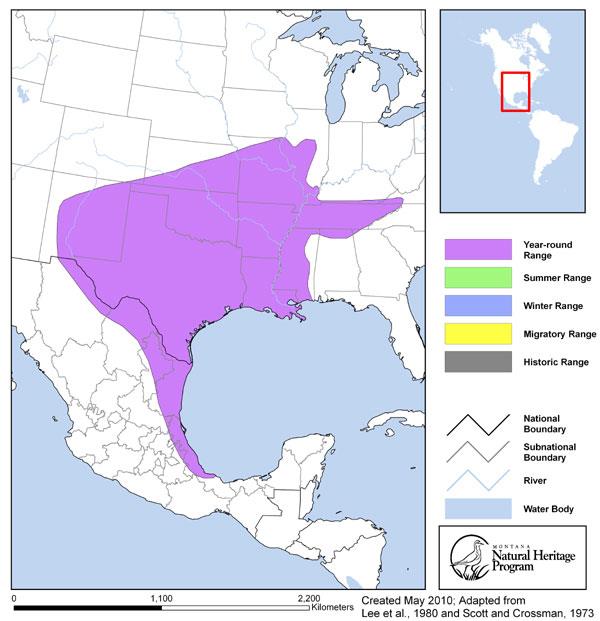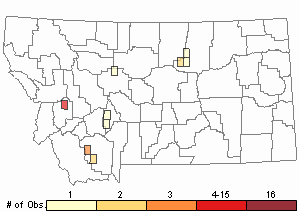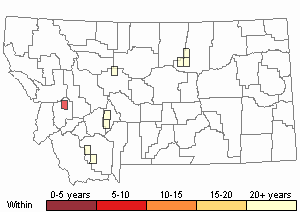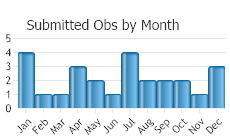View in other NatureServe Network Field Guides
NatureServe
Montana
Utah
Wyoming
Idaho
Wisconsin
British Columbia
South Carolina
Yukon
California
New York
Western Mosquitofish - Gambusia affinis
General Description
The only livebearer species widely distributed, the mosquitofish, is established in a thermal spring east of the Divide and can be found in other non-thermal waters in the eastern drainages during the summer. The wider summer distribution is the result of the State Board of Health planting them in mosquito-infested areas. Mosquitofish are planted because they eat crustaceans and insects on or near the water's surface, including a high number of mosquito larvae when available. Mosquitofish thus serve as a biological control for mosquitoes. Mosquitofish do not overwinter in Montana in non-thermal waters. This species shows marked sexual differences with females becoming larger than males. Females can reach about 3 inches in length.
Diagnostic Characteristics
Color is light olive to dull silver. Lateral line is absent.
Species Range
Introduced Not Established
Western Hemisphere Range

Observations in Montana Natural Heritage Program Database
Number of Observations: 28
(Click on the following maps and charts to see full sized version)
Map Help and Descriptions
Relative Density

Recency



 (Observations spanning multiple months or years are excluded from time charts)
(Observations spanning multiple months or years are excluded from time charts)
Habitat
Year round survival in Montana is restricted to waters with thermal influences (Elser et al. 1980).
Food Habits
Includes all kinds of tiny aquatic plants and animals. Usually feeds at surface in very shallow water where mosquito larvae are typically found (Brown 1971).
Ecology
Females larger than males.
Reproductive Characteristics
Sexually mature in 4-6 wks. Internal fertilization. The eggs hatch internally and young emerge as free-swimming individuals. Fry produce March - Oct. in one Montana pond studied (Brown 1971).
Management
Stewardship Responsibility
References
- Literature Cited AboveLegend:
 View Online Publication
View Online Publication Brown, C.J.D. 1971. Fishes of Montana. Bozeman, MT: Big Sky Books/Montana State University. 207 p.
Brown, C.J.D. 1971. Fishes of Montana. Bozeman, MT: Big Sky Books/Montana State University. 207 p. Elser A., C. Clancy, L. Morris, M. Georges 1980 (revised). Aquatic habitat inventory of the Beaver Creek drainage and selected tributaries of the Yellowstone River. BLM report: YS-512-CT7-74. 86 pp.
Elser A., C. Clancy, L. Morris, M. Georges 1980 (revised). Aquatic habitat inventory of the Beaver Creek drainage and selected tributaries of the Yellowstone River. BLM report: YS-512-CT7-74. 86 pp.
- Additional ReferencesLegend:
 View Online Publication
View Online Publication
Do you know of a citation we're missing? Joslin, Gayle, and Heidi B. Youmans. 1999. Effects of recreation on Rocky Mountain wildlife: a review for Montana. [Montana]: Montana Chapter of the Wildlife Society.
Joslin, Gayle, and Heidi B. Youmans. 1999. Effects of recreation on Rocky Mountain wildlife: a review for Montana. [Montana]: Montana Chapter of the Wildlife Society. Land & Water Consulting, Inc., Missoula, MT., 2002, Montana Dept. of Transportation Wetland Mitigation Monitoring Report, Year 2001: Beaverhead Gateway, Dillon, Montana. Proj. No. 130091.011. July 2002. In 2001 Wetland Mitigation Monitoring Reports, Vol. I.
Land & Water Consulting, Inc., Missoula, MT., 2002, Montana Dept. of Transportation Wetland Mitigation Monitoring Report, Year 2001: Beaverhead Gateway, Dillon, Montana. Proj. No. 130091.011. July 2002. In 2001 Wetland Mitigation Monitoring Reports, Vol. I. Mulla, M.S. 1963. Toxicity of organochlorine insecticides to the mosquito fish Gambusia affinis and the bullfrog Rana catesbeiana. Mosquito News 23(4): 299-303.
Mulla, M.S. 1963. Toxicity of organochlorine insecticides to the mosquito fish Gambusia affinis and the bullfrog Rana catesbeiana. Mosquito News 23(4): 299-303. Sylvester, R. and B. Marotz. 2006. Evaluation of the Biological Effects of the Northwest Power Conservation Council's Mainstem Amendment on the Fisheries Upstream and Downstream of Hungry Horse and Libby Dams, Montana. Montana Fish, Wildlife, and Parks Annual Report prepared for U.S. Department of EnergyBonneville Power Administration. Bonneville Power Administration Project No. 2006-008-00 Contract No. 28350. 124 p.Contract No. 28350
Sylvester, R. and B. Marotz. 2006. Evaluation of the Biological Effects of the Northwest Power Conservation Council's Mainstem Amendment on the Fisheries Upstream and Downstream of Hungry Horse and Libby Dams, Montana. Montana Fish, Wildlife, and Parks Annual Report prepared for U.S. Department of EnergyBonneville Power Administration. Bonneville Power Administration Project No. 2006-008-00 Contract No. 28350. 124 p.Contract No. 28350 Sylvester, R. and B. Stephens. 2011. Evaluation of the physical and biological effects of the Northwest Power Conservation Council's Mainstem Amendment upstream and downstream of Libby Dam, Montana. Libby, MT: Montana Fish, Wildlife, and Parks Annual Report prepared for U.S. Department of Energy Bonneville Power Administration. Bonneville Power Administration Project No. 2006-008-00, Contract Nos. 43309 and 48555. 282 p.
Sylvester, R. and B. Stephens. 2011. Evaluation of the physical and biological effects of the Northwest Power Conservation Council's Mainstem Amendment upstream and downstream of Libby Dam, Montana. Libby, MT: Montana Fish, Wildlife, and Parks Annual Report prepared for U.S. Department of Energy Bonneville Power Administration. Bonneville Power Administration Project No. 2006-008-00, Contract Nos. 43309 and 48555. 282 p. Sylvester, R., A. Steed, J. Tohtz, and B. Marotz. 2008. Evaluation of the Biological Effects of the Northwest Power Conservation Council's Mainstem Amendment on the Fisheries Upstream and Downstream of Hungry Horse and Libby Dams, Montana. Montana Fish, Wildlife, and Parks Annual Report prepared for U.S. Department of EnergyBonneville Power Administration. Bonneville Power Administration Project No. 2006-008-00 Contract No. 28350. 124 p.Contract No. 28350
Sylvester, R., A. Steed, J. Tohtz, and B. Marotz. 2008. Evaluation of the Biological Effects of the Northwest Power Conservation Council's Mainstem Amendment on the Fisheries Upstream and Downstream of Hungry Horse and Libby Dams, Montana. Montana Fish, Wildlife, and Parks Annual Report prepared for U.S. Department of EnergyBonneville Power Administration. Bonneville Power Administration Project No. 2006-008-00 Contract No. 28350. 124 p.Contract No. 28350
- Web Search Engines for Articles on "Western Mosquitofish"
- Additional Sources of Information Related to "Fish"





